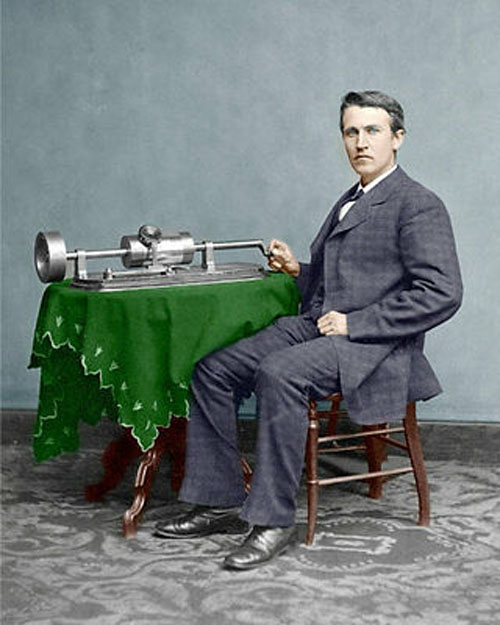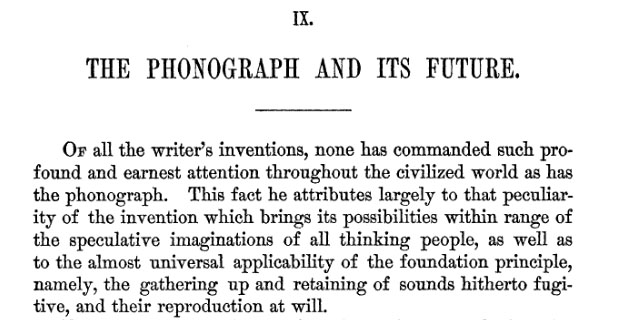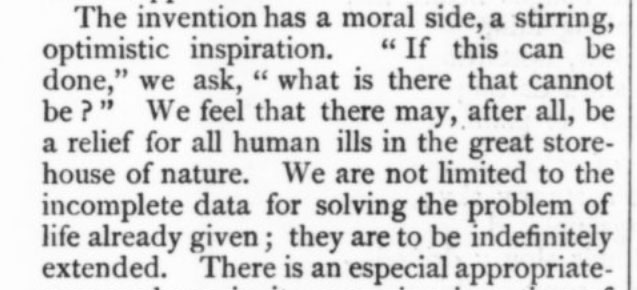The
Phonograph and Its Future

Predictions
and Possibilities identified by Thomas Edison in The
North American Review May-June 1878

In April 1878 Edison took
his Phonograph to Washington, D.C. and demonstrated it to the National
Academy of Sciences at the Smithsonian, to Congress, to President
Hayes and his wife per a late night invitation by the White House;
he had his photograph taken at the Mathew Brady Studio, and answered
innumerable questions about the phonograph wherever he went. The public
was fascinated with a machine that "bottles up sound" for
future use and imaginations were running wild.
Indeed, there were so many
questions about how this talking machine worked and how it might be
used in the future that Edison wrote an article for The North American
Review to address a wider audience. As Edison noted in the second
paragraph of his article: "the possibilities are so illimitable
and the probabilities so numerous that he"..."is himself
in a somewhat chaotic condition of mind as to where to draw the dividing
line."
Edison wrote about the
development process, explained some essential sound related principles,
features and the mechanics of how it works, and enumerated "under
the head of probabilities" that each will be "specially
considered. Among the more important may be mentioned: Letter writing,
and other forms of dictation, books, education, reader, music, family
record; and such electrotype applications as books, musical-boxes,
toys, clocks, advertising and signaling apparatus, speeches, etc.,
etc."
All of Edison's probabilities
became true.
This gallery looks at each
of Edison's 1878 enumerated 'probabilities' and provides examples
and additional information about the "realization" for each
one.
Letter
Writing. --
The apparatus now being perfected in mechanical details will be the
standard phonograph, and may be used for all purposes, except such
as require special form of matrix, such as toys, clocks, etc., for
an indefinite repetition of the same thing. The main utility of the
phonograph, however, being for the purpose of letter-writing and other
forms of dictation, the design is made with a view to its utility
for that purpose.
Dictation
- All kinds and manner of dictation which will permit of the application
of the mouth of the speaker to the mouth-piece of the phonograph may
be as readily effected by the phonograph as in the case of letters.
If the matter is for the printer, he would much prefer, in setting
it up in type, to use his ears in lieu of his eyes. He has other use
for them. It would be even worth while to compel witnesses in court
to speak directly into the phonograph, in order to thus obtain an
unimpeachable record of their testimony. The increased delicacy of
the phonograph, which is in the near future, will enlarge this field
rapidly. It may then include all the sayings of not only the witness,
but the judge and the counsel. It will then also comprehend the utterances
of public speakers.
Books.
-- Books may be read by the charitably-inclined profes sional
reader, or by such readers especially employed for that purpose, and
the record of such book used in the asylums of the blind, hospitals,
the sick-chamber, or even with great profit and amusement by the lady
or gentleman whose eyes and hands may be otherwise employed; or, again,
because of the greater enjoy ment to be had from a book when read
by an elocutionist than when read by the average reader. The ordinary
record-sheet, repeating this book from fifty to a hundred times as
it will, would command a price that would pay the original reader
well for the slightly-increased difficulty in reading it aloud in
the phonograph.
Educational
Purposes. -- As an elocutionary
teacher, or as a primary teacher for children, it will certainly be
invaluable. By it difficult passages may be correctly rendered for
the pupil but once, after which he has only to apply to his phonograph
for in instructions. The child may thus learn to spell, commit to
memory, a lesson set for it, etc., etc.
Music.--
The phonograph will undoubtedly be liberally
devoted to music. A song sung on the phonograph is reproduced with
marvelous accuracy and power. Thus a friend may in a morning-call
sing us a song which shall delight an evening company, etc. As a musical
teacher it will be used to enable one to master a new air, the child
to form its first songs, or to sing him to sleep.
Family
Record. -- For the purpose of preserving the sayings,
the voices, and the last words of the dying member of the family
-- as of great men--the phonograph will unquestionably outrank the
photograph.
Phonographic
Books. -- A book of 40,000 words upon a single metal plate
ten inches square thus becomes a strong probability. The advantages
of such books over those printed are too readily seen to need mention.
Such books would be listened to where now none are read. They would
preserve more than the mental emanations of the brain of the author;
and, as a bequest to future generations, they would be unequaled.
For the preservation of languages they would be invaluable.
Musical-Boxes.
-- The only element not absolutely assured, in the result of experiments
thus far made--which stands in the way of a perfect reproduction at
will of Adelina Patti's voice in all its purity--is the single one
of quality, and even that is not totally lacking, and will doubtless
be wholly attained. If, however, it should not, the musical-box, or
cabinet, of the present, will be superseded by that which will give
the voice and the words of the human songstress.
Toys.
-- A doll which may speak, sing, cry, or laugh, may be safely
promised our children for the Christmas holidays ensuing. Every species
of animal or mechanical toy--such as locomotives, etc.--may be supplied
with their natural and characteristic sounds.
Clocks.
-- The phonographic clock will tell you the hour of the day; call
you to lunch; send your lover home at ten, etc.
Advertising,
etc. -- This class of phonographic work is so akin to
the foregoing, that it is only necessary to call attention to it.
Speech
and other Utterances
- It will henceforth be possible to preserve for future generations
the voices as well as the words of our Washingtons, our Lincolns,
our Gladstones, etc., and to have them give us their " greatest effort"
in every town and hamlet in the country, upon our holidays.
Perfect
the telephone and revolutionize present systems of telegraphy
- Connecting up with
the telephone as a permanent record of what was said....the speaker
will be able to simultaneously transmit and record his message.
Other contemporary
articles about the Phonograph's Future and Possible Uses
Oakland
Daily Evening Tribune, May 1, 1878 - "Possible Uses
of the Phonograph"
"If
It Could Have Been. A Retrospective," by Col. Robert
G. Ingersoll, in which he laments the absence of the Phonograph in
the past. The Phonogram, January 1, 1891.
"A
Night with Edison," November
1878,
Scribner's - This article is a history and "more
personal view" of Edison, the inventor, who is opening a new
period in the world's development. It is not "necessary to amplify
further upon the scientific aspects" of the phonograph, "or
those ingenious speculations as to its future when it is perfected"
because "every active imagination can supply itself." Instead,
there is a "moral side of the invention, a stirring, optimistic
inspiration" which will change everything.

"A Night with
Edison," November 1878, Scribner's,
p.88